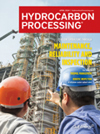October 2021
Hydrogen
Monitoring hydrogen plant performance—Part 1
Process monitoring is an indispensable practice to keep track of key performance indicators (KPIs) of the hydrogen (H2) plant.

 COPYING AND DISTRIBUTING ARE PROHIBITED WITHOUT PERMISSION OF THE PUBLISHER
COPYING AND DISTRIBUTING ARE PROHIBITED WITHOUT PERMISSION OF THE PUBLISHER
Process monitoring is an indispensable practice to keep track of key performance indicators (KPIs) of the hydrogen (H2) plant.

Comments